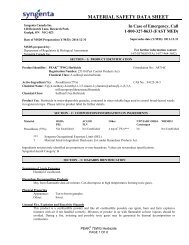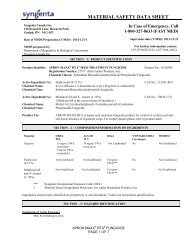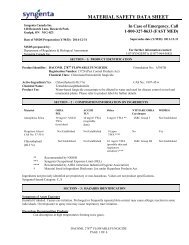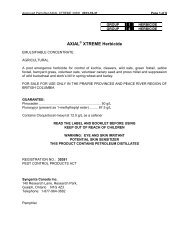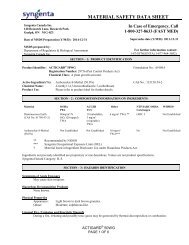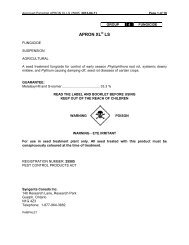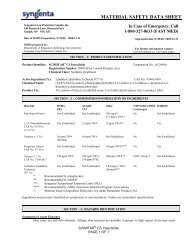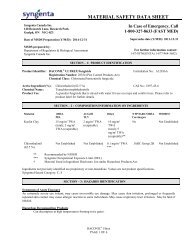Target MSDS - Syngenta Farm
Target MSDS - Syngenta Farm
Target MSDS - Syngenta Farm
- No tags were found...
You also want an ePaper? Increase the reach of your titles
YUMPU automatically turns print PDFs into web optimized ePapers that Google loves.
SECTION – 6: ACCIDENTAL RELEASE MEASURESPersonal Precautions: Make sure all personnel involved in the spill cleanup follow good industrial hygiene practices. A smallspill can be handled routinely. Wear suitable protective equipment and clothing as described in Section 8 and/or the productlabel.Procedures for dealing with release or spill: Control the spill at its source. Contain the spill to prevent from spreading orcontaminating soil or from entering sewage and drainage systems or any body of water. Clean up spills immediately,observing precautions outlined in Sections 7 and 8. Pump or scoop large amounts of liquid into a disposable container.Absorb remaining liquid or smaller spills with clay, sand or vermiculite. Scoop or sweep up material and place into adisposal container. Wash area with detergent and water. Pick up wash liquid with additional absorbent and place intocompatible disposal container. On soils, small amounts will naturally decompose. For large amounts, skim off the uppercontaminated layer and collect for disposal. Once all material is cleaned up and placed in a disposal container, sealcontainer and arrange for disposition. Spillages or uncontrolled discharges into watercourses must be reported to theappropriate regulatory body.SECTION – 7: HANDLING AND STORAGEHandling practices: KEEP OUT OF REACH OF CHILDREN. Prevent eating, drinking, tobacco use, and cosmeticapplication in areas where there is a potential for exposure to the material. Avoid breathing vapours or spray mist. Wear fullprotective clothing and equipment (see Section 8). After work, rinse gloves and remove protective equipment, and washhands thoroughly with soap and water after handling, and before eating, tobacco use, drinking, applying cosmetics or usingthe toilet. Wash contaminated clothing before re-use and separate from household laundry. Keep containers closed whennot in use. Protect product, wash or rinse water, and contaminated materials from uncontrolled release into theenvironment, or from access by animals, birds or unauthorized people.Appropriate storage practices/requirements: Store in original container only in a well-ventilated, cool, dry, secure area.Protect from heat, sparks and flame. Do not expose sealed containers to temperatures above 40 °C. Keep separate fromother products to prevent cross contamination. Rotate stock. Clean up spilled material immediately.National Fire Code classification: Not required.SECTION – 8: EXPOSURE CONTROLS/PERSONAL PROTECTIONApplicable control measures, including engineering controls: Ensure work areas have ventilation, containment, andprocedures sufficient to maintain airborne levels below the TLV. Warehouses, production area, parking lots and waste holdingfacilities must have adequate containment to prevent environmental contamination. Provide separate shower and eatingfacilities.THE FOLLOWING RECOMMENDATIONS FOR EXPOSURE CONTROLS/PERSONAL PROTECTION ARE INTENDEDFOR THE MANUFACTURE, FORMULATION, PACKAGING AND USE OF THIS PRODUCT.CONSULT THE PRODUCT LABEL FOR COMMERCIAL APPLICATIONS AND/OR ON-FARM APPLICATIONS.Personal protective equipment for each exposure route:General: Avoid breathing dust, vapours or aerosols. Avoid contact with eye, skin and clothing. Wash thoroughly after handlingand before eating, drinking, applying cosmetics or handling tobacco.INGESTION: Do not eat, drink, handle tobacco, or apply cosmetics in areas where there is a potential for exposure tothis material. Always wash thoroughly after handling.EYES: Where eye contact is likely, use chemical splash goggles. Facilities storing or utilizing this materialSKIN:should be equipped with an eyewash facility and a safety shower.Where contact is likely, wear chemical-resistant gloves (such as nitrile or butyl), coveralls, socks andchemical-resistant footwear. For overhead exposure, wear chemical-resistant headgear.INHALATION: A respirator is not normally required when handling this substance. Use process enclosures, local exhaustventilation, or other engineering controls to keep airborne levels below exposure limits. A NIOSHcertifiedcombination air-purifying respirator with an N, P, R or HE class filter and an organic vapourcartridge may be used under certain circumstances where airborne concentrations are expected to exceedexposure limits (e.g. emergency spills).TARGET ® HerbicidePAGE 3 OF 7



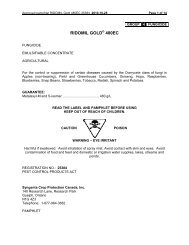
![gesagard 480sc [pamphlet] - Syngenta Crop Protection](https://img.yumpu.com/50945984/1/190x245/gesagard-480sc-pamphlet-syngenta-crop-protection.jpg?quality=85)
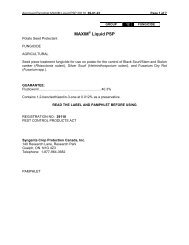
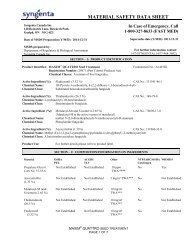
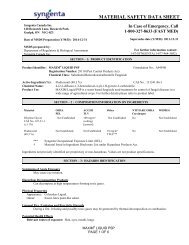
![ridomil Gold mz 68wp [bag] - Syngenta Farm](https://img.yumpu.com/49025229/1/190x245/ridomil-gold-mz-68wp-bag-syngenta-farm.jpg?quality=85)
